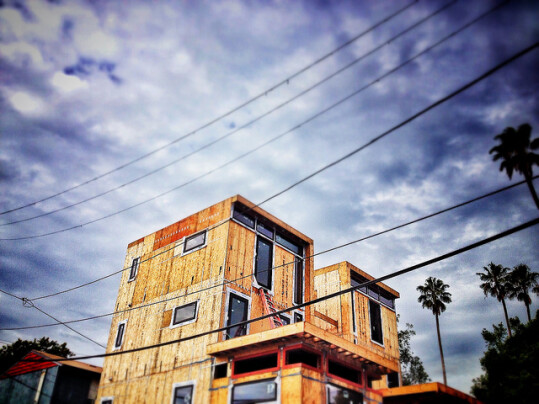There’s a reason the National Association of Home Builders has surveyed builders each month for the past 35 years. It’s because, when business is good for builders, things are generally good for the housing market and overall economy. In other words, if builders are doing well, things are heading in the right direction. And, if that’s true, their most recent Housing Market index is an encouraging sign. That’s because, the index – which is scored on a scale where any number above 50 indicates more builders view conditions as good than poor – hit 90 for the first time in its history. That exceeds the previous all-time high of 85, set last month. Robert Dietz, NAHB’s chief economist, says the housing market continues to lead the economy. “Another record high for the HMI reflects that housing is a bright spot for the economy,” Dietz said. “In the short run, the shift of housing demand to lower density markets such as suburbs and exurbs with ongoing low resale inventory levels is supporting demand for home building.” (source)
Archive for November 2020
Mortgage Credit More Available In October
The Mortgage Bankers Association’s Mortgage Credit Availability Index measures how easy or difficult it is for borrowers to secure financing. If the index increases, that means lending standards have loosened and borrowers should expect to have an easier time qualifying for a loan. When it tightens, the opposite is true. In October, the MBA found the index up 2.3 percent from the month before. Joel Kan, MBA’s associate vice president of economic and industry forecasting, said it was the first increase since July. “Credit availability increased in October for the first time since July,” Kan said. “The ongoing economic recovery and improving labor market led to a rise in credit supply for various loan types.” Among them, there was an increase in credit availability for low credit score loans and loans with higher loan-to-value ratios. Still, despite the improvement, credit availability remains tighter than it’s been in recent years. In fact, the index is at a level last seen in 2014. (source)
Majority Of Buyers Face Bidding Wars In October
There are different types of competition. Some are more enjoyable than others. Competition on a golf course, for example, can be fun, while in the housing market, competition can cause buyers and their budgets stress. That’s why a new report detailing how many homes for sale received multiple offers in October offers good and bad news. The good news is that the number of homes facing competition during the month fell slightly from the month before and is almost 3 percent lower than its peak in August. But while competition for available homes has calmed down a bit since the height of the summer market, it’s still high. In fact, 56.8 percent of homes sold in October faced at least one competing bid, according to the report. And, depending on which market you look at, the number can get even higher. Hot markets like Salt Lake City, San Diego, San Francisco, and Austin lead the list of the most competitive markets. However, in Las Vegas, Miami, Chicago, and Detroit – which were among the least competitive metros – you’re less likely to find yourself in a bidding war. (source)
Third Quarter Home Prices Up Everywhere
The monthly mortgage payment on the typical single-family home is now $1,059, according to new third-quarter data from the National Association of Realtors. Up $27 from last year, the increase comes as the NAR’s most recent quarterly price report shows home prices up in every measured metro area. In fact, more than half of the included cities had double-digit increases and all four major regions were up year-over-year. Lawrence Yun, NAR’s chief economist, says rising prices are going to affect affordability conditions, regardless of how low mortgage rates go. “Favorable mortgage rates will continue to bring fresh buyers to the market,” Yun said. “However, the affordability situation will not improve even with low interest rates because housing prices are increasing much too fast.” But why are prices rising? Well, part of it is too few homes for sale. The pandemic caused already low inventory to fall further. And too few available homes, combined with elevated buyer demand, has caused more competition and bidding wars, which push prices higher. (source)
Demand For Home Purchase Loans Slows
According to the Mortgage Bankers Association’s Weekly Applications Survey, average mortgage rates were down last week for 30-year fixed-rate mortgages with both conforming and jumbo balances. Loans backed by the Federal Housing Administration and 15-year fixed-rate loans were both unchanged from the week before. But despite rates still hovering near record lows, mortgage demand slowed from the week before. Joel Kan, MBA’s associate vice president of economic and industry forecasting, says home buyer demand is still higher than last year, but low inventory is starting to take its toll. “The purchase market continued its recent slump, with the index decreasing for the sixth time in seven weeks to its lowest level since May 2020,” Kan said. “Home buyer demand is still strong overall, and activity was up 16.5 percent from a year ago. However, inadequate housing supply is putting upward pressure on home prices and is impacting affordability – especially for first-time buyers and lower-income buyers.” The MBA’s weekly survey has been conducted since 1990 and covers 75 percent of all retail residential mortgage applications. (source)
Mortgage Rates Expected To Stay Low Through 2021
Favorable mortgage rates have helped the housing market handle affordability challenges, low inventory, and the coronavirus. With record low rates counteracting continuing price increases, demand from home buyers has stayed strong and the market has been resilient. And fortunately, according to a recent forecast from Freddie Mac, low rates aren’t going anywhere any time soon. “One of the main drivers of the strong housing recovery is historically low mortgage interest rates,” the forecast reads. “Given weakness in the broader economy, the Federal Reserve’s signal that its policy rate will remain low until inflation picks up, and no signs of inflation, we forecast mortgage rates to remain flat over the next year.” In fact, Freddie Mac says rates should continue to hover just above record lows through the end of 2021. That’s good news for anyone interested in buying a home any time soon. It’s also encouraging for current homeowners who may be able to benefit from refinancing. (source)
Americans Say It’s A Good Time To Buy
The share of Americans who say it’s a good time to buy a home rose in October, according to a recent survey from Fannie Mae. The Home Purchase Sentiment Index – which measures Americans feelings about buying and selling homes, mortgage rates, prices, the job market, and their financial situation – found there was a 9 percent month-over-month gain in the number of respondents who say it’s a good time to buy. Similarly, the share of participants who said it’s a good time to sell a house also rose, climbing 6 percent from the month before. Doug Duncan, Fannie Mae’s senior vice president and chief economist, said housing market sentiment has rebounded significantly since the coronavirus pandemic began. “To date, the HPSI has recovered over 60 percent of its COVID-19 pandemic loss, reflecting the bright spot that the mortgage market has been in the economy,” Duncan said. “However, the continuing evolution of the pandemic and the 2020 election outcomes may have longer lasting and unexpected impacts on consumer sentiment, as we saw following the 2016 elections, and we expect both factors will shape the housing market over the coming months.” (source)







